浅谈none_none_of的用法
No one, none、nobody与nothing的区别
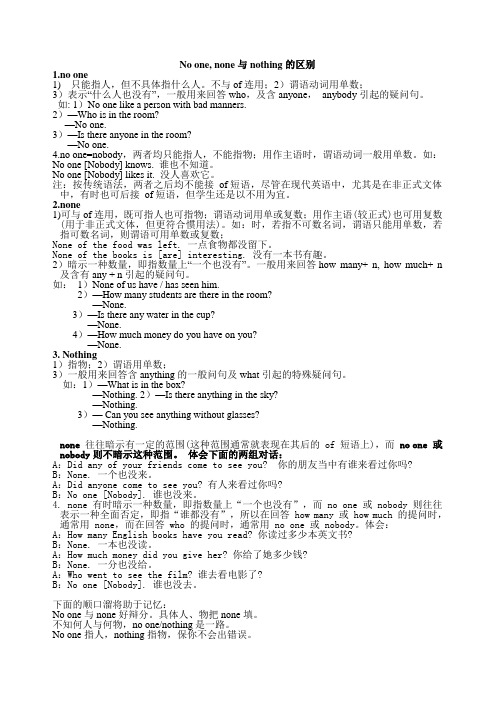
No one, none与nothing的区别1.no one1) 只能指人,但不具体指什么人。
不与of连用;2)谓语动词用单数;3)表示“什么人也没有”,一般用来回答who,及含anyone,anybody引起的疑问句。
如: 1)No one like a person with bad manners.2)—Who is in the room?—No one.3)—Is there anyone in the room?—No one.4.no one=nobody,两者均只能指人,不能指物;用作主语时,谓语动词一般用单数。
如:No one [Nobody] knows. 谁也不知道。
No one [Nobody] likes it. 没人喜欢它。
注:按传统语法,两者之后均不能接of 短语,尽管在现代英语中,尤其是在非正式文体中,有时也可后接of 短语,但学生还是以不用为宜。
2.none1)可与of连用,既可指人也可指物;谓语动词用单或复数;用作主语(较正式)也可用复数(用于非正式文体,但更符合惯用法)。
如:时,若指不可数名词,谓语只能用单数,若指可数名词,则谓语可用单数或复数;None of the food was left. 一点食物都没留下。
None of the books is [are] interesting. 没有一本书有趣。
2)暗示一种数量,即指数量上“一个也没有”。
一般用来回答how many+ n, how much+ n 及含有any + n引起的疑问句。
如:1)None of us have / has seen him.2)—How many students are there in the room?—None.3)—Is there any water in the cup?—None.4)—How much money do you have on you?—None.3. Nothing1)指物;2)谓语用单数;3)一般用来回答含anything的一般问句及what引起的特殊疑问句。
英语易错词汇:nobody与none用法区别
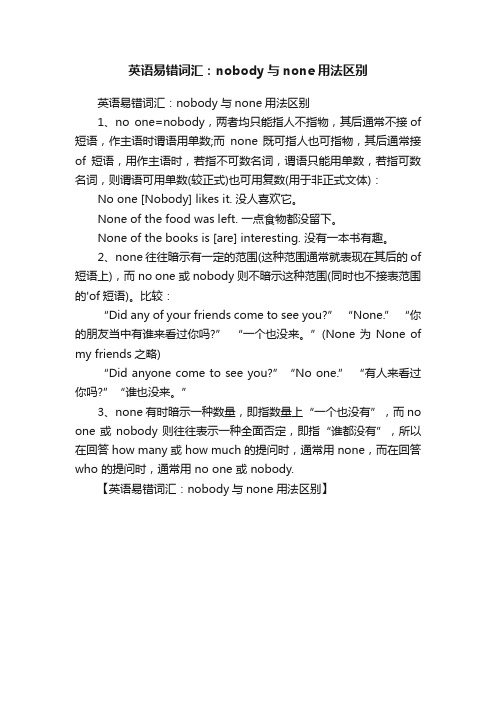
英语易错词汇:nobody与none用法区别
英语易错词汇:nobody与none用法区别
1、no one=nobody,两者均只能指人不指物,其后通常不接of 短语,作主语时谓语用单数;而none 既可指人也可指物,其后通常接of短语,用作主语时,若指不可数名词,谓语只能用单数,若指可数名词,则谓语可用单数(较正式)也可用复数(用于非正式文体):No one [Nobody] likes it. 没人喜欢它。
None of the food was left. 一点食物都没留下。
None of the books is [are] interesting. 没有一本书有趣。
2、none 往往暗示有一定的范围(这种范围通常就表现在其后的of 短语上),而 no one 或 nobody 则不暗示这种范围(同时也不接表范围的'of短语)。
比较:
“Did any of your friends come to see you?” “None.” “你的朋友当中有谁来看过你吗?” “一个也没来。
”(None为None of my friends之略)
“Did anyone come to see you?”“No one.” “有人来看过你吗?”“谁也没来。
”
3、none 有时暗示一种数量,即指数量上“一个也没有”,而 no one 或 nobody 则往往表示一种全面否定,即指“谁都没有”,所以在回答 how many 或 how much 的提问时,通常用 none,而在回答who 的提问时,通常用 no one 或 nobody.
【英语易错词汇:nobody与none用法区别】。
辨析none of,all of
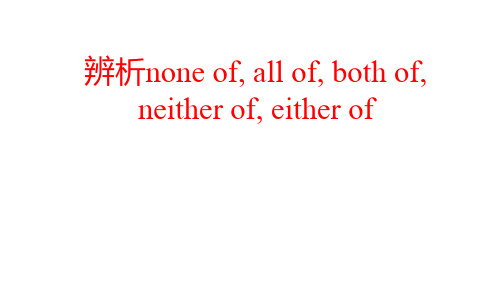
5. _N__o_n_e_o_f_ the students is afraid of difficulties. 没有一个同学害怕困难。
辨析none of, all of, both of, neither of, either of
辨析none of, all of, both of, neither of, either of
广州华腾教育科技股份有限公司 版权所有
知识点讲解 Chairman Mao is a great man. Premier Zhou is a great man.
Both of them are great men.
good at dancing. 李莉和露西都喜欢唱歌,但是她们两人都不擅长跳舞。 2. __E_it_h_e_r_o_f___ the two magazines is useful. 这两本杂志中的任意一本都是有用的。
3. _B_o_t_h__o_f _ my parents are teachers. 我的父母都是老师。
both of表示“两者都……”,后面接复数名词或代词, 谓语动词用复数。
知识点讲解 Tom is not tall. Jim is not tall.
Neither of them is tall. 单数
neither of表示“两者都不……”,后面接复数名词或代词, 谓语动词用单数。
知识点讲解
both of neither of all of none of either of
两者都……
谓语用复数
两者都不……
谓语用单数
none 谓语

none 谓语
none 作句子主语时,如果指人或可数的事物,谓语动词用单数、复数形式皆可;如果指不可数名词,谓语动词用单数。
为none 后面接of 限制时,可以根据of 后面的名词来判断使用单复数。
如果没有of 限制,则根据语境判断。
例句:
1. None of the students have/has made mistakes this time. 这次没有一个学生犯错误。
2. None of us is/are interested in your new subject. 我们中没人对你的新课题感兴趣。
3. None of the stories are/is intersting. 没有一个故事有趣味。
4. None have/has noticed this. 没人注意到这个情况。
(none 指人,不可能指物)
5. Jimmy took away all the books. None were/was left. 吉米拿走了所有的书,一本也没剩下。
(none 指可数的物)
6. Jimmy has used up all the money. None is left. 吉米把所有的钱都用光了,一点没留。
(none 指不可数的物)。
初三英语中考语法详解(31)不定代词no,none,all,both用法知识点总结整理

初三英语中考语法考点重难点详解(31)不定代词no,none,all,both用法知识点总结整理不定代词是一种指代不明确的代词,在英语中具有代词的功能,可以代替名词或者形容词,可以作主语、宾语、表语、定语,也可以作状语。
不定代词是英语学习的重点,也是难点,今天我们只讲四个不定代词的用法:no,none,all 和both。
1. nono 是个形容词,直接修饰名词,作定语用,表示“没有”。
用no 作定语的句子,一般可以用not...any这样的句子做同义句转换。
比如:I have no time. 我没时间。
There are no potatoes left. 没有土豆了。
= There are not any topatoes left.2. none不能作定语,只能独立使用,但是可作主语、宾语和表语,意为“没有一个”,可以替代单数也可以替代复数。
如:None of our classmates can make out that maths problem. 我们的同学中,没有一个会做那道数学题。
He has a lot of photos, but none of them is valueable. 他有很多照片,但是没有一张有价值的。
1. no one与nobody同义,均只能指人,不能指物;用作主语时,谓语动词一般用单数,且其后一般接表范围的of短语。
如:No one [Nobody] knows. 谁也不知道。
No one [Nobody] likes it. 没人喜欢它。
2. none 既可指人也可指物,其后通常接of 短语;用作主语时,若指不可数名词,谓语只能用单数,若指可数名词,则谓语可用单数(较正式)也可用复数(用于非正式文体,但更符合惯用法)。
如:None of the food was left. 一点食物都没留下。
None of the books is [are] interesting. 没有一本书有趣。
none nobody nothing no one 最优讲解与练习
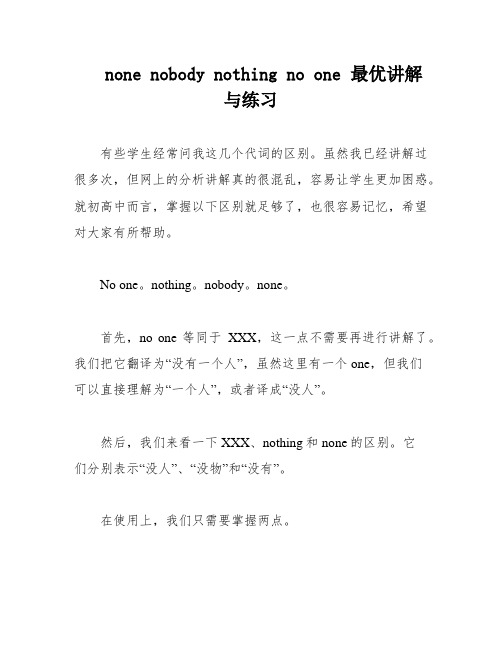
none nobody nothing no one 最优讲解与练习有些学生经常问我这几个代词的区别。
虽然我已经讲解过很多次,但网上的分析讲解真的很混乱,容易让学生更加困惑。
就初高中而言,掌握以下区别就足够了,也很容易记忆,希望对大家有所帮助。
No one。
nothing。
nobody。
none。
首先,no one等同于XXX,这一点不需要再进行讲解了。
我们把它翻译为“没有一个人”,虽然这里有一个one,但我们可以直接理解为“一个人”,或者译成“没人”。
然后,我们来看一下XXX、nothing和none的区别。
它们分别表示“没人”、“没物”和“没有”。
在使用上,我们只需要掌握两点。
首先,nobody和nothing后面一般不加of。
这是因为它们本来就是复合不定代词,再加of就显得累赘了。
其次,none在很多情况下需要在句中带上of。
我们知道,在英语中,of一词有这样一种用法,表示从中取多少,取某样的意思。
比如,在一个很大的群体里取一个叫one of,o of,取一些叫some of,取大多数叫most of,取全部用all of。
那么一个也不取就用none of了解这一点,你就能很轻易地区分somestudents和some of the students。
再比如,the color of the book,我们可以解释为of表示无生命的所有格,也可以解释为取书的颜色,而不是内容或封面等其他的。
好了,这样我们应该能够理解为什么XXX和nothing不能加of,而none可以了。
XXX is "none"。
When we use "none" in reference to three or more things。
it means "not any"。
In this case。
the speaker is saying that none of their new classmates are as good to them as Bruce。
none的详细用法

none的详细用法今天给大家带来none的用法,快来一起学习吧,下面就和大家分享,来欣赏一下吧。
none的用法none的用法是英语代词中一个易混知识点,也是高考英语中的一个常见考点。
很多学习者容易把none的用法与nobody 的用法相混淆。
下文将给出一个简要分析。
none的用法一:用于陈述句none的基本词义是“一个(点)都没有,毫无”,既可以指代可数名词,也可以指代不可数名词。
从词义实质上看,它是一个“数(量)”的代词,而不是对具体“人”或“物”描述的代词,通常都会与of连用,来指代前面说到的、或下文即将要说的人(物)中一个(点)都没。
在这一点上,none的用法与nobody是有明显区别的,因为nobody可以看成是“no one”的缩略形式,所以nobody的词义落脚点还在表示人的“one(人)”上面,表示“无人,没有人”,没有范围可言,故不与of连用。
例1:I came bake to get my money, only to find that none (of it) was still there in my safe.我是回来拿钱的,到头来却发现保险柜里的钱全没了。
例2:I had expected to visit my friends in Beijing, but none (of them) stayed home during the holiday.我本来打算去看看北京的几位朋友,但是假期他们一个人都不在家。
例3:Nobody knows what the future holds for us.谁也不知都未来是个什么样子。
none的用法二:用于回答疑问句上文已经说到,none实际上是描述数(量)的代词,所以在回答how many或how much的提问时,如果表示“一个(点)没有”,就该用none;相反,如果用who或者what进行提问的句子强调的就不是数(量)而是“人”或者“物”,所以在完全否定回答的时候就该用“nobody”或“nothing”例1:— How many passengers are still on the bus? 公交车上还有多少人?—None. 一个都没有。
none的用法详解

n o n e_的用法详解集团档案编码:[YTTR-YTPT28-YTNTL98-UYTYNN08]n o n e的用法详解1.none与noone/nobody 及nothingnoone/nobody常用来指人,作主语时谓语动词要用单数形式;nothing常用来指物,作主语时谓语动词也要用单数形式;none可指人也可指物,作主语时,如和of连用指不可数名词时,谓语动词要用单数形式;指可数名词时,谓语动词用单、复数均可。
如:Noone likes apersonwit hbadmanners.Nothing is difficultin theworldifyouputyour heartintoit. Noneofthem has/have se enmebefore. Noneofthismoney belon gs tome.注意:1)none可与of连用表示范围,而noone/nobody及nothing不可。
2)none可用来回答Howmany/much…?的特殊疑问句;而noone/nobody及nothing则分别用来回答Who…?和What…?的特殊疑问句。
如:—Howmanybirdsarethere inthetree?—None.—Whatisinthebox?—Nothing.—Whoisintheclassroom ?—Noone/Nobody.3)none可用来回答“any+名词”构成的一般疑问句:而nobody和nothing则分别用来回答由anybody和anything构成的一般疑问句。
如:—Isthereanybreadleft ?—No,noneatall.—Isthereanythinginthe sky?—No,nothing.4)none可用来指代前面提到过的人或物;如无指代时可用noone/nobody及nothing.如:Wehadthreecatsonce—noneofthemisalivenow.2.none与notall/all…notnotall/all…not表示三者或三者以上的部分否定;而none表示三者或三者以上的全部否定。
none的用法
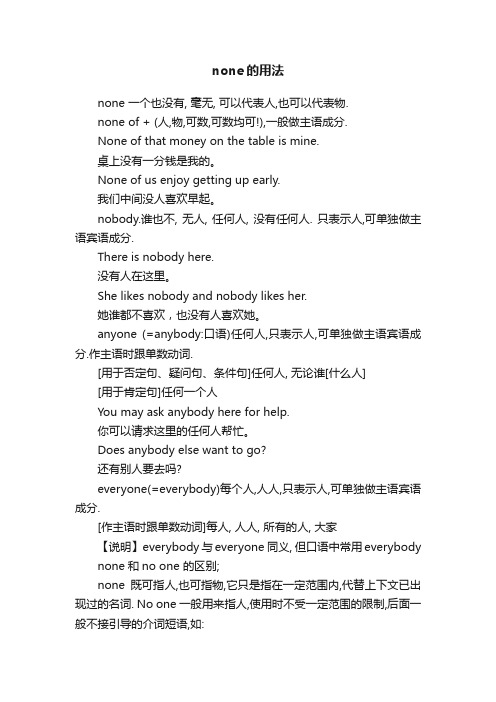
none的用法none 一个也没有, 毫无, 可以代表人,也可以代表物.none of + (人,物,可数,可数均可!),一般做主语成分.None of that money on the table is mine.桌上没有一分钱是我的。
None of us enjoy getting up early.我们中间没人喜欢早起。
nobody.谁也不, 无人, 任何人, 没有任何人. 只表示人,可单独做主语宾语成分.There is nobody here.没有人在这里。
She likes nobody and nobody likes her.她谁都不喜欢,也没有人喜欢她。
anyone (=anybody:口语)任何人,只表示人,可单独做主语宾语成分.作主语时跟单数动词.[用于否定句、疑问句、条件句]任何人, 无论谁[什么人][用于肯定句]任何一个人You may ask anybody here for help.你可以请求这里的任何人帮忙。
Does anybody else want to go?还有别人要去吗?everyone(=everybody)每个人,人人,只表示人,可单独做主语宾语成分.[作主语时跟单数动词]每人, 人人, 所有的人, 大家【说明】everybody与everyone 同义, 但口语中常用everybody none和no one 的区别;none既可指人,也可指物,它只是指在一定范围内,代替上下文已出现过的名词. No one 一般用来指人,使用时不受一定范围的限制,后面一般不接引导的介词短语,如:"Have you bought any clothes" "None"."你买衣服了吗 ""一件没买". "What did you buy yesterday " "None""昨天你买什么了 ""没有买什么".no one ,none与nothing之别1.no one (等于nobody)1)不与of连用;2)谓语动词用单数;3)只能指人,但不具体指什么人;4)一般用来回答who,及含anyone,anybody引起的疑问句。
none用法大全!!
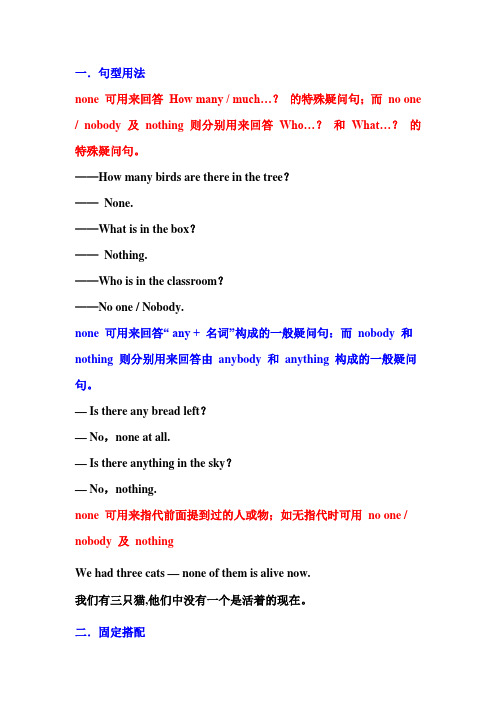
一.句型用法none 可用来回答How many / much…?的特殊疑问句;而no one / nobody 及nothing 则分别用来回答Who…?和What…?的特殊疑问句。
——How many birds are there in the tree?——None.——What is in the box?——Nothing.——Who is in the classroom?——No one / Nobody.none 可用来回答“ any + 名词”构成的一般疑问句:而nobody 和nothing 则分别用来回答由anybody 和anything 构成的一般疑问句。
— Is there any bread left?— No,none at all.— Is there anything in the sky?— No,nothing.none 可用来指代前面提到过的人或物;如无指代时可用no one / nobody 及nothingWe had three cats — none of them is alive now.我们有三只猫,他们中没有一个是活着的现在。
二.固定搭配1. none 与not all / all…notnot all / all…not意为“并不是所有的”表示三者或三者以上的部分否定;而none 表示三者或三者以上的全部否定。
Not all ads are good. 并非所有的广告都好。
All are not friends that speak us fair.向我们说好话的并不都是好朋友。
2. none but,nobody but及nothing but①.nobody but表示“除了…没有人”,表示单一概念,谓语动词用单数形式。
Nobody but he is often late for school. 除他以外,没有人上学常迟到。
②.none but表示“只有”可指人也可指物,通常指前面提到的同一事物,谓语动词要用复数形式。
最新浅谈none-none-of的用法

浅谈none的用法1. none 与no one / nobody 及nothingno one / nobody 常用来指人,作主语时谓语动词要用单数形式;nothing 常用来指物,作主语时谓语动词也要用单数形式;none 可指人也可指物,作主语时,如和of 连用指不可数名词时,谓语动词要用单数形式;指可数名词时,谓语动词用单、复数均可。
如:No one likes a person with bad manners.Nothing is difficult in the world if you put your heart into it.None of them has / have seen me before.None of this money belongs to me.注意:1 )none 可与of 连用表示范围,而no one / nobody 及nothing 不可。
2 )none 可用来回答How many / much…?的特殊疑问句;而no one / nobody 及nothing 则分别用来回答W ho…?和What…?的特殊疑问句。
如:— How many birds are there in the tree?— None.— What is in the box?— Nothing.— Who is in the classroom?— No one / Nobody.3 )none 可用来回答“ any + 名词”构成的一般疑问句:而nobody 和nothing 则分别用来回答由anybody 和anything 构成的一般疑问句。
如:— Is there any bread left?— No,none at all.— Is there anything in the sky?— No,nothing.4 )none 可用来指代前面提到过的人或物;如无指代时可用no one / nobody 及nothing .如:We had three cats once — none of them is alive now.2. none 与not all / all…notnot a ll / all…not 表示三者或三者以上的部分否定;而none 表示三者或三者以上的全部否定。
none of them还是none of which_用法辨析 英语语法.doc
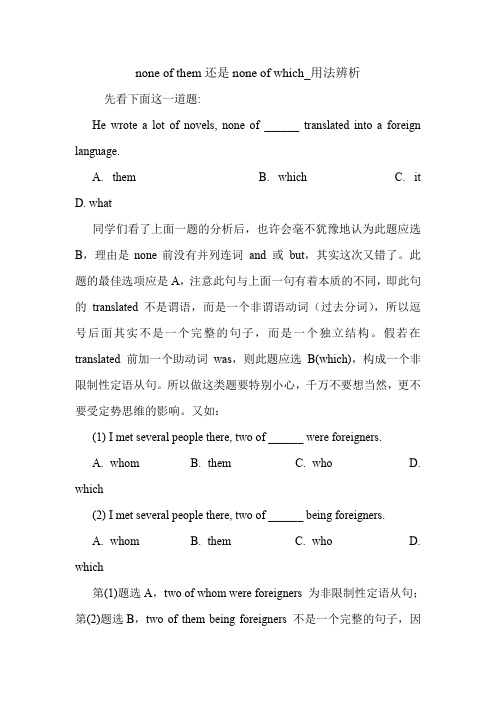
none of them还是none of which_用法辨析
先看下面这一道题:
He wrote a lot of novels, none of ______ translated into a foreign language.
A. them
B. which
C. it
D. what
同学们看了上面一题的分析后,也许会毫不犹豫地认为此题应选B,理由是none前没有并列连词and 或but,其实这次又错了。
此题的最佳选项应是A,注意此句与上面一句有着本质的不同,即此句的translated 不是谓语,而是一个非谓语动词(过去分词),所以逗号后面其实不是一个完整的句子,而是一个独立结构。
假若在translated 前加一个助动词was,则此题应选B(which),构成一个非限制性定语从句。
所以做这类题要特别小心,千万不要想当然,更不要受定势思维的影响。
又如:
(1) I met several people there, two of ______ were foreigners.
A. whom
B. them
C. who
D. which
(2) I met several people there, two of ______ being foreigners.
A. whom
B. them
C. who
D. which
第(1)题选A,two of whom were foreigners 为非限制性定语从句;第(2)题选B,two of them being foreigners 不是一个完整的句子,因
为句子没有谓语,而只有非谓语动词being。
none of用法总结
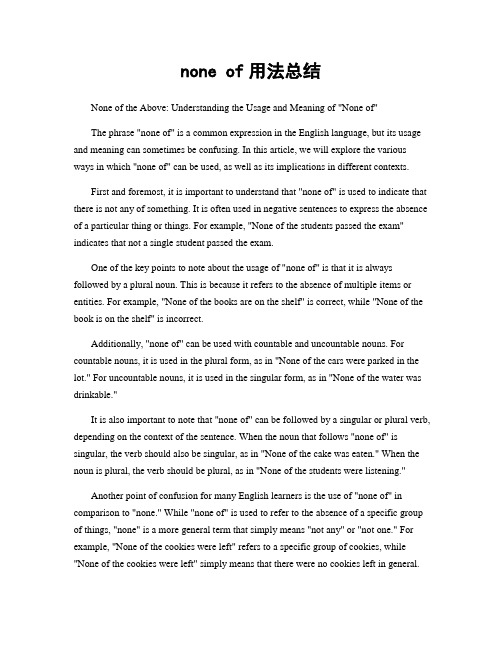
none of用法总结None of the Above: Understanding the Usage and Meaning of "None of"The phrase "none of" is a common expression in the English language, but its usage and meaning can sometimes be confusing. In this article, we will explore the various ways in which "none of" can be used, as well as its implications in different contexts.First and foremost, it is important to understand that "none of" is used to indicate that there is not any of something. It is often used in negative sentences to express the absence of a particular thing or things. For example, "None of the students passed the exam" indicates that not a single student passed the exam.One of the key points to note about the usage of "none of" is that it is always followed by a plural noun. This is because it refers to the absence of multiple items or entities. For example, "None of the books are on the shelf" is correct, while "None of the book is on the shelf" is incorrect.Additionally, "none of" can be used with countable and uncountable nouns. For countable nouns, it is used in the plural form, as in "None of the cars were parked in the lot." For uncountable nouns, it is used in the singular form, as in "None of the water was drinkable."It is also important to note that "none of" can be followed by a singular or plural verb, depending on the context of the sentence. When the noun that follows "none of" is singular, the verb should also be singular, as in "None of the cake was eaten." When the noun is plural, the verb should be plural, as in "None of the students were listening."Another point of confusion for many English learners is the use of "none of" in comparison to "none." While "none of" is used to refer to the absence of a specific group of things, "none" is a more general term that simply means "not any" or "not one." For example, "None of the cookies were left" refers to a specific group of cookies, while "None of the cookies were left" simply means that there were no cookies left in general.In some cases, "none of" can be used to emphasize the absence of something in a particular group or category. For example, "None of the candidates were qualified for the position" emphasizes that not a single candidate met the qualifications for the position. In this way, "none of" can be used to highlight the complete absence of something within a specific context.It is also worth noting that "none of" can be used in both formal and informal language. It is a versatile expression that can be used in a variety of settings, from academic writing to casual conversation. However, it is important to use it correctly to avoid misunderstandings or confusion.In conclusion, the phrase "none of" is a useful and versatile expression in the English language. It is used to indicate the absence of something in a specific group or category, and it can be used with both countable and uncountable nouns. By understanding the proper usage and meaning of "none of," English learners can effectively communicate the absence of something in a clear and precise manner.。
none of用法总结
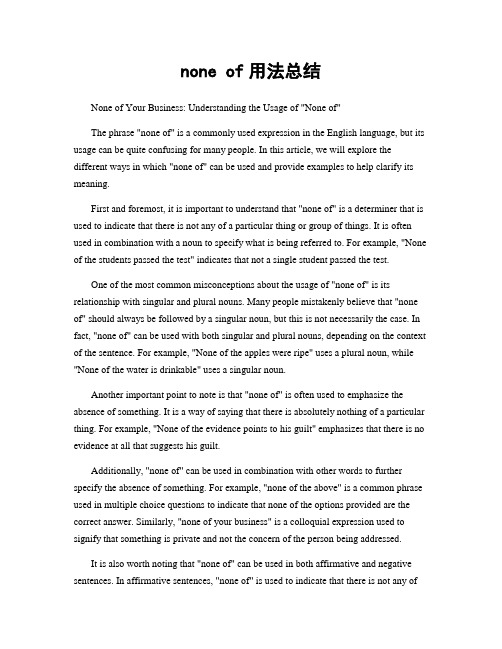
none of用法总结None of Your Business: Understanding the Usage of "None of"The phrase "none of" is a commonly used expression in the English language, but its usage can be quite confusing for many people. In this article, we will explore the different ways in which "none of" can be used and provide examples to help clarify its meaning.First and foremost, it is important to understand that "none of" is a determiner that is used to indicate that there is not any of a particular thing or group of things. It is often used in combination with a noun to specify what is being referred to. For example, "None of the students passed the test" indicates that not a single student passed the test.One of the most common misconceptions about the usage of "none of" is its relationship with singular and plural nouns. Many people mistakenly believe that "none of" should always be followed by a singular noun, but this is not necessarily the case. In fact, "none of" can be used with both singular and plural nouns, depending on the context of the sentence. For example, "None of the apples were ripe" uses a plural noun, while "None of the water is drinkable" uses a singular noun.Another important point to note is that "none of" is often used to emphasize the absence of something. It is a way of saying that there is absolutely nothing of a particular thing. For example, "None of the evidence points to his guilt" emphasizes that there is no evidence at all that suggests his guilt.Additionally, "none of" can be used in combination with other words to further specify the absence of something. For example, "none of the above" is a common phrase used in multiple choice questions to indicate that none of the options provided are the correct answer. Similarly, "none of your business" is a colloquial expression used to signify that something is private and not the concern of the person being addressed.It is also worth noting that "none of" can be used in both affirmative and negative sentences. In affirmative sentences, "none of" is used to indicate that there is not any ofsomething, while in negative sentences, it is used to reinforce the absence of something. For example, "None of the guests have arrived yet" is an affirmative sentence, while "None of the students have not completed the assignment" is a negative sentence.Furthermore, "none of" can be used with both countable and uncountable nouns. Countable nouns are things that can be counted and have a singular and plural form, such as "apple" and "apples." Uncountable nouns, on the other hand, are things that cannot be counted and do not have a plural form, such as "water" and "evidence." "None of" can be used with both types of nouns, as demonstrated in the examples above.In conclusion, the usage of "none of" can be quite versatile and is not limited to singular or plural nouns. It is used to indicate the absence of something and can be used in both affirmative and negative sentences. Additionally, it can be used with both countable and uncountable nouns, depending on the context of the sentence. Understanding the nuances of "none of" can help improve one's proficiency in the English language and ensure that it is used correctly in various contexts.。
none的用法总结大全
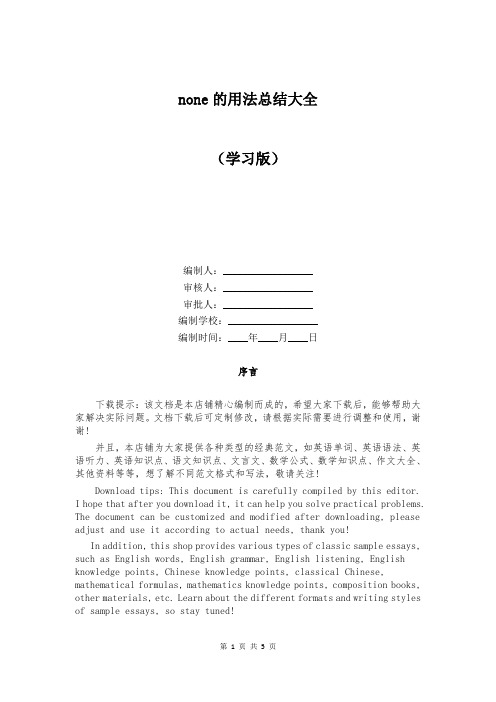
none的用法总结大全(学习版)编制人:__________________审核人:__________________审批人:__________________编制学校:__________________编制时间:____年____月____日序言下载提示:该文档是本店铺精心编制而成的,希望大家下载后,能够帮助大家解决实际问题。
文档下载后可定制修改,请根据实际需要进行调整和使用,谢谢!并且,本店铺为大家提供各种类型的经典范文,如英语单词、英语语法、英语听力、英语知识点、语文知识点、文言文、数学公式、数学知识点、作文大全、其他资料等等,想了解不同范文格式和写法,敬请关注!Download tips: This document is carefully compiled by this editor.I hope that after you download it, it can help you solve practical problems. The document can be customized and modified after downloading, please adjust and use it according to actual needs, thank you!In addition, this shop provides various types of classic sample essays, such as English words, English grammar, English listening, English knowledge points, Chinese knowledge points, classical Chinese, mathematical formulas, mathematics knowledge points, composition books, other materials, etc. Learn about the different formats and writing styles of sample essays, so stay tuned!none的用法总结大全none的意思pron. 没有人,没有一人;没有一个;没有一部分,没有一点;adv. 根本不;无法,绝不;none的用法none 与 no one / nobody 及 nothing的用法区别no one / nobody 常用来指人,作主语时谓语动词要用单数形式;nothing 常用来指物,作主语时谓语动词也要用单数形式;none 可指人也可指物,作主语时,如和 of 连用指不可数名词时,谓语动词要用单数形式;指可数名词时,谓语动词用单、复数均可。
none of us的谓语动词用法

none of us的谓语动词用法“None of us”的谓语动词用法在英语学习中,“none of us”这个短语的谓语动词用法常常让学习者感到困惑。
为了能够准确地理解和运用这一表达方式,我们有必要对其进行深入探讨。
首先,“none of us”表示“我们当中没有一个人”,强调的是个体的否定。
当它作主语时,谓语动词的单复数形式需要根据具体语境来判断。
一般来说,如果“none of us”后面接的是不可数名词,谓语动词通常用单数形式。
例如:“None of us has the answer to this difficult question”(我们当中没有一个人有这个难题的答案。
)这里的“answer”是不可数名词,所以谓语动词用“has”。
然而,如果“none of us”后面接的是可数名词复数,谓语动词既可以用单数,也可以用复数。
但在现代英语中,用单数形式更为常见。
比如:“None of us is perfect”(我们当中没有一个人是完美的。
)再如:“None of us were invited to the party”(我们当中没有一个人被邀请参加聚会。
)尽管这种复数形式也是正确的,但在实际使用中,“None of us was invited to the party”可能会更常见。
需要注意的是,“none of us”和“neither of us”在意思和用法上有一定的区别。
“neither of us”表示“我们两个当中没有一个”,谓语动词通常用单数形式。
例如:“Neither of us likes this movie”(我们两个都不喜欢这部电影。
)此外,“none of us”还可以与其他词语搭配使用,来表达更丰富的意思。
比如“none of us except”(除了我们当中的)、“none of us at all”(我们当中根本没有一个人)等。
在实际的语言交流和写作中,正确使用“none of us”的谓语动词形式能够使我们的表达更加准确和清晰。
none of them造句简单

none of them造句简单在英语中,我们经常使用“none of them”这个短语来表达“没有一个”的意思。
但是,实际上,这个短语的语法结构并不是很简单,而且初学者常常会在使用它的时候出现错误。
在这篇文章中,我们将会深入探讨“none of them”这个短语的用法,解释它的语法结构,并提供一些简单的例句,帮助读者更好地理解和运用这个短语。
首先,让我们看一下“none of them”的基础用法。
在一般情况下,我们使用这个短语来表示某个集合、群体或者一组人或物中没有一个符合某种特定的条件。
例如:- None of them are doctors.(他们中没有一个是医生。
) - None of them like vegetables.(他们中没有人喜欢蔬菜。
) - None of them can swim.(他们中没有一个会游泳。
)这些例句展示了“none of them”作为主语的用法,它通常和动词的复数形式一起使用。
这个短语实际上是由三个部分组成的,分别是“none”(没有一个)、“of”(属于)和“them”(他们)。
整个短语的意思是“他们中没有一个(符合某种条件)”。
除了作为主语,我们还可以使用“none of them”作为其他成分的修饰语。
比如说,在下面这个句子中,它作为宾语出现:- She invited all of her friends to the party, but none of them came.(她邀请了所有的朋友参加聚会,但是没有一个人来。
)在这个例子中,“none of them”修饰了动词“came”,表示没有一个人来参加聚会。
那么,“none of them”可以用在什么类型的句子中呢?它常常用在否定句中,但是也可以用在肯定句中,只不过需要使用倒装语序。
比如说:- None of them are doctors.(否定句) - All of them are doctors, none of them are lawyers.(肯定句,倒装语序)值得注意的是,“none of them”并不是一个所有时态都适用的短语。
- 1、下载文档前请自行甄别文档内容的完整性,平台不提供额外的编辑、内容补充、找答案等附加服务。
- 2、"仅部分预览"的文档,不可在线预览部分如存在完整性等问题,可反馈申请退款(可完整预览的文档不适用该条件!)。
- 3、如文档侵犯您的权益,请联系客服反馈,我们会尽快为您处理(人工客服工作时间:9:00-18:30)。
浅谈none的用法
1. none 与no one / nobody 及nothing
no one / nobody 常用来指人,作主语时谓语动词要用单数形式;nothing 常用来指物,作主语时谓语动词也要用单数形式;none 可指人也可指物,作主语时,如和of 连用指不可数名词时,谓语动词要用单数形式;指可数名词时,谓语动词用单、复数均可。
如:
No one likes a person with bad manners.
Nothing is difficult in the world if you put your heart into it.
None of them has / have seen me before.
None of this money belongs to me.
注意:
1 )none 可与of 连用表示范围,而no one / nobody 及nothing 不可。
2 )none 可用来回答How many / much…?的特殊疑问句;而no one / nobody 及nothing 则分别用来回答W ho…?和What…?的特殊疑问句。
如:
— How many birds are there in the tree?
— None.
— What is in the box?
— Nothing.
— Who is in the classroom?
— No one / Nobody.
3 )none 可用来回答“ any + 名词”构成的一般疑问句:而nobody 和nothing 则分别用来回答由anybody 和anything 构成的一般疑问句。
如:
— Is there any bread left?
— No,none at all.
— Is there anything in the sky?
— No,nothing.
4 )none 可用来指代前面提到过的人或物;如无指代时可用no one / nobody 及nothing .如:
We had three cats once — none of them is alive now.
2. none 与not all / all…not
not a ll / all…not 表示三者或三者以上的部分否定;而none 表示三者或三者以上的全部否定。
如:
Not all ads are good. 并非所有的广告都好。
3. none but,nobody but 及nothing but
nobody but 表示单一概念,谓语动词用单数形式;none but 可指人也可指物,通常指前面提到的同一事物,谓语动词要用复数形式;nothing but 泛指but 后事物以外的任何事物。
如:
Nobody but he is often late for school. 除他以外,没有人上学常迟到。
None but fools have even believed it. 除了傻瓜,没有人相信这一点。
There is a variety of fruit,but he chose nothing but an apple.
这儿有很多水果,但他只选了一个苹果。
4. 其他用法
1 )none 可指物质名词或抽象概念,构成短语have none of ,意为“不允许;不接受;拒绝参加”,常和will / would 连用,表示意愿。
如:
I will have none of your stupid ideas!
2 )none other than 意为“就是;恰恰是”。
如:
The new arrival was none other than the President.。
